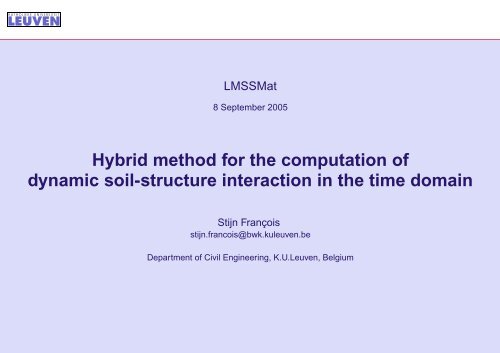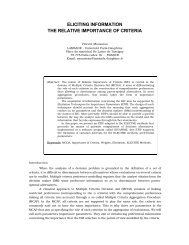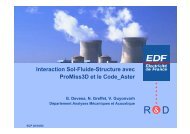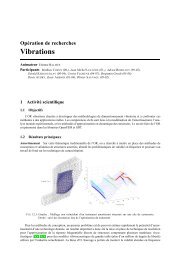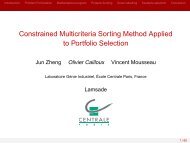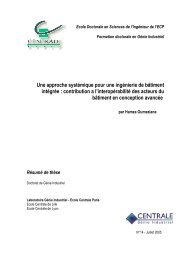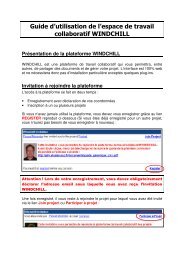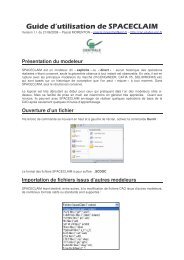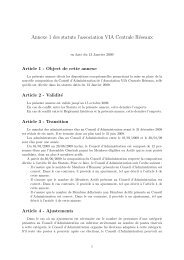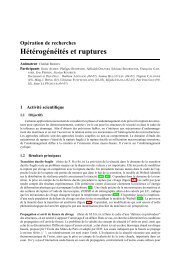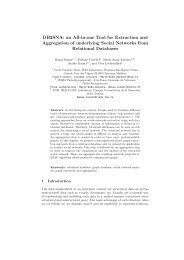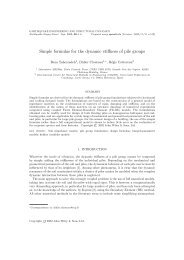Hybrid method for the computation of dynamic soil-structure ...
Hybrid method for the computation of dynamic soil-structure ...
Hybrid method for the computation of dynamic soil-structure ...
Create successful ePaper yourself
Turn your PDF publications into a flip-book with our unique Google optimized e-Paper software.
IntroductionFramework: <strong>dynamic</strong> <strong>soil</strong>-<strong>structure</strong> interactionIntroduction<strong>Hybrid</strong> <strong>method</strong>Time Domain BEMFE-BEConclusionsLMSSMat <strong>Hybrid</strong> <strong>method</strong> <strong>for</strong> <strong>the</strong> <strong>computation</strong> <strong>of</strong> <strong>dynamic</strong> <strong>soil</strong>-<strong>structure</strong> interaction in <strong>the</strong> time domain - p. 2/44
IntroductionLinear and non-linear solution domainsIntroductionLinear<strong>Hybrid</strong> <strong>method</strong>Time Domain BEMLinear■ Traffic induced vibrations■ Machine vibrationsFE-BEConclusionsΣ bs⇒ Frequency domain, interface modes.Non-linearLinear■ Vibration related structural damage■ Earthquake engineeringΣ bs⇒ Time domain, interface modes.Non-linearNon-linearΣ bs■ Vibration related settlements■ Pile driving■ Earthquake engineering⇒ Time domain, no interface modes.LMSSMat <strong>Hybrid</strong> <strong>method</strong> <strong>for</strong> <strong>the</strong> <strong>computation</strong> <strong>of</strong> <strong>dynamic</strong> <strong>soil</strong>-<strong>structure</strong> interaction in <strong>the</strong> time domain - p. 3/44
IntroductionAlternatives <strong>for</strong> time domain <strong>dynamic</strong> SSIIntroduction<strong>Hybrid</strong> <strong>method</strong>Time Domain BEMFE-BEConclusions■ Linear calculations: frequency domain boundary element <strong>method</strong> .■ Non-linear calculations:Fundamental solution Soil stiffness ResponseTime domain BEM ω → t t t<strong>Hybrid</strong> domain <strong>method</strong>using <strong>soil</strong> flexibilityin <strong>the</strong> time domain<strong>Hybrid</strong> frequency-timedomain analysisω ω → t tω ω ω ↔ tObjectiveInvestigate <strong>the</strong> applicability <strong>of</strong> time domain <strong>soil</strong>-<strong>structure</strong> interaction <strong>method</strong>s.LMSSMat <strong>Hybrid</strong> <strong>method</strong> <strong>for</strong> <strong>the</strong> <strong>computation</strong> <strong>of</strong> <strong>dynamic</strong> <strong>soil</strong>-<strong>structure</strong> interaction in <strong>the</strong> time domain - p. 4/44
IntroductionPresentation outlineIntroduction<strong>Hybrid</strong> <strong>method</strong>Time Domain BEM■ Dynamic <strong>soil</strong>-<strong>structure</strong> interaction <strong>method</strong>ology◆ Flexibility in <strong>the</strong> time domainyzxP ztFE-BEConclusions◆ Time domain boundary elements■ Implementation <strong>of</strong> a FE-BE couplingΩ bΩ sΣ rsΣ bszyxΩ rLMSSMat <strong>Hybrid</strong> <strong>method</strong> <strong>for</strong> <strong>the</strong> <strong>computation</strong> <strong>of</strong> <strong>dynamic</strong> <strong>soil</strong>-<strong>structure</strong> interaction in <strong>the</strong> time domain - p. 5/44
Introduction<strong>Hybrid</strong> <strong>method</strong>Time Domain BEMFE-BEConclusionsPart I: Dynamic <strong>soil</strong>-<strong>structure</strong> interactionin <strong>the</strong> time domainLMSSMat <strong>Hybrid</strong> <strong>method</strong> <strong>for</strong> <strong>the</strong> <strong>computation</strong> <strong>of</strong> <strong>dynamic</strong> <strong>soil</strong>-<strong>structure</strong> interaction in <strong>the</strong> time domain - p. 6/44
<strong>Hybrid</strong> domain <strong>method</strong>Benchmark problem: square foundationIntroduction<strong>Hybrid</strong> <strong>method</strong>■ Dimensionless massTime Domain BEMFE-BEConclusionsyzx¯m = mρd 3■ Dimensionless frequencyd¯md■ Dimensionless timea 0 = ωdC sµ, ρ, ν = 1 3τ = tC sd■ Dimensionless responseµdu i , µd 3 ϕ iLMSSMat <strong>Hybrid</strong> <strong>method</strong> <strong>for</strong> <strong>the</strong> <strong>computation</strong> <strong>of</strong> <strong>dynamic</strong> <strong>soil</strong>-<strong>structure</strong> interaction in <strong>the</strong> time domain - p. 7/44
<strong>Hybrid</strong> domain <strong>method</strong>Frequency domain stiffnessIntroduction<strong>Hybrid</strong> <strong>method</strong>Time Domain BEMFE-BEˆf s (ω) = Ŝ(ω)û(ω) (1))Ŝ mn (a 0 ) = K mn(ˆkmn (a 0 ) + ia 0 ĉ mn (a 0 )(2)ConclusionsImpedance coefficient [−]10.80.60.40.2Impedance coefficient [−]10.80.60.40.2Impedance coefficient [−]10.80.60.40.200 2 4 6 8Frequency [−]00 2 4 6 8Frequency [−]00 2 4 6 8Frequency [−]ˆk HH (a 0 ), ĉ HH (a 0 ) ˆkV V (a 0 ), ĉ V V (a 0 ) ˆkRR (a 0 ), ĉ RR (a 0 )LMSSMat <strong>Hybrid</strong> <strong>method</strong> <strong>for</strong> <strong>the</strong> <strong>computation</strong> <strong>of</strong> <strong>dynamic</strong> <strong>soil</strong>-<strong>structure</strong> interaction in <strong>the</strong> time domain - p. 8/44
<strong>Hybrid</strong> domain <strong>method</strong>Frequency domain flexibilityIntroduction<strong>Hybrid</strong> <strong>method</strong>Time Domain BEMû(ω) = ˆF(ω)ˆf s (ω) (3)ˆF(ω) = (Ŝ)−1 (ω) (4)FE-BEConclusions1.51.51.5Flexibility [−]10.5Flexibility [−]10.5Flexibility [−]10.500 2 4 6 8Frequency [−]00 2 4 6 8Frequency [−]00 2 4 6 8Frequency [−]ˆF HH (a 0 ) ˆFV V (a 0 ) ˆFRR (a 0 )LMSSMat <strong>Hybrid</strong> <strong>method</strong> <strong>for</strong> <strong>the</strong> <strong>computation</strong> <strong>of</strong> <strong>dynamic</strong> <strong>soil</strong>-<strong>structure</strong> interaction in <strong>the</strong> time domain - p. 9/44
<strong>Hybrid</strong> domain <strong>method</strong>Time domain stiffness and flexibilityIntroduction<strong>Hybrid</strong> <strong>method</strong>Time Domain BEMFE-BEConclusions■ Stiffness relation in <strong>the</strong> time domain.f s (t) =∫ τ0S(t − τ)u(τ) dτ◆ Ŝ(ω) Linear asymptotic behaviour <strong>for</strong> ω → ∞.◆ There<strong>for</strong>e, S(t) contains singular terms <strong>for</strong> t = 0.■ Flexibility relation in <strong>the</strong> time domain.u(t) =∫ τ0F(t − τ)f s (τ)dτ◆ ˆF(ω) Converges to zero <strong>for</strong> ω → ∞.◆ However, large frequency content <strong>for</strong> large frequencies.LMSSMat <strong>Hybrid</strong> <strong>method</strong> <strong>for</strong> <strong>the</strong> <strong>computation</strong> <strong>of</strong> <strong>dynamic</strong> <strong>soil</strong>-<strong>structure</strong> interaction in <strong>the</strong> time domain - p. 10/44
<strong>Hybrid</strong> domain <strong>method</strong>Alternative 1: Gauss windowing techniqueIntroduction<strong>Hybrid</strong> <strong>method</strong>Time Domain BEMFE-BEConclusionsGauss window [−]10.80.60.40.200 0.1 0.2 0.3 0.4 0.5Frequency [−]Gauss window [−]0.250.20.150.10.050−10 −5 0 5 10Time [−]g(ω) = exp −σ 2 ω 2g(t) = 12σ √ π exp(− t4σ ) 2■ The flexibility is multiplied with <strong>the</strong> Gauss window.■ Problem: entire frequency domain influenced → large frequency range required.Alternative 2:Properly account <strong>for</strong> <strong>the</strong> asymptotic behaviour <strong>of</strong> <strong>the</strong> <strong>soil</strong> flexibility in <strong>the</strong> frequencydomain.LMSSMat <strong>Hybrid</strong> <strong>method</strong> <strong>for</strong> <strong>the</strong> <strong>computation</strong> <strong>of</strong> <strong>dynamic</strong> <strong>soil</strong>-<strong>structure</strong> interaction in <strong>the</strong> time domain - p. 11/44
Asymptotic expansion <strong>for</strong> ω → ∞<strong>Hybrid</strong> domain <strong>method</strong>Introduction<strong>Hybrid</strong> <strong>method</strong>Time Domain BEMyxyxFE-BEConclusionszz■ A direct stiffness approach is considered (Luco and Apsel 1983)■ Out-<strong>of</strong>-plane motion:√˜K SH (k x , ω) = iµω 2C 2 s− k 2 x ∼ iωρC s <strong>for</strong> ω → ∞ (5)■ In-plane motion:˜K P−SV (k x , ω) =[µkx 2 + k zs k zp∼ iωρ[ ]C s 00 C p]iks 2k zp k x (2kx 2 − k2 s + 2k zsk zp )k x (2kx 2 − ks 2 + 2k zs k zp ) iksk 2 zs<strong>for</strong> ω → ∞ (6)LMSSMat <strong>Hybrid</strong> <strong>method</strong> <strong>for</strong> <strong>the</strong> <strong>computation</strong> <strong>of</strong> <strong>dynamic</strong> <strong>soil</strong>-<strong>structure</strong> interaction in <strong>the</strong> time domain - p. 12/44
Asymptotic expansion <strong>for</strong> ω → ∞<strong>Hybrid</strong> domain <strong>method</strong>Introduction<strong>Hybrid</strong> <strong>method</strong>Time Domain BEMFE-BEConclusions■ Force-displacement relationship <strong>for</strong> ω → ∞:ũ x (k x , ω) = iωρC s˜t x (k x , ω) (7)ũ y (k x , ω) = iωρC s˜t y (k x , ω) (8)ũ z (k x , ω) = iωρC p˜t z (k x , ω) (9)■ The stiffnesses are independent <strong>of</strong> <strong>the</strong> wavenumber:û x (x, ω) = iωρC sˆt x (x, ω) (10)û y (x, ω) = iωρC sˆt y (x, ω) (11)û z (x, ω) = iωρC pˆt z (x, ω) (12)■ The result is extended to <strong>the</strong> 3D-case, using a Fourier series in <strong>the</strong> circumferentialdirection. The results remain valid.LMSSMat <strong>Hybrid</strong> <strong>method</strong> <strong>for</strong> <strong>the</strong> <strong>computation</strong> <strong>of</strong> <strong>dynamic</strong> <strong>soil</strong>-<strong>structure</strong> interaction in <strong>the</strong> time domain - p. 13/44
Asymptotic expansion <strong>for</strong> ω → ∞<strong>Hybrid</strong> domain <strong>method</strong>Introduction<strong>Hybrid</strong> <strong>method</strong>Time Domain BEMFE-BEConclusions■ For <strong>the</strong> foundation under consideration, this is integrated:F HH ∼F V V ∼F RR ∼ 112F T T ∼ 8 3d2iωρC s(13)d2iωρC p(14)d 4iωρC p(15)d 4iωρC p(16)■ Similar results apply <strong>for</strong> a layered halfspace, if material damping is present. In thiscase, <strong>the</strong> wave velocities are rendered complex.■ For an embedded foundation, <strong>the</strong> 1D wave propagation is in <strong>the</strong> direction <strong>of</strong> <strong>the</strong>normal on <strong>the</strong> interface.LMSSMat <strong>Hybrid</strong> <strong>method</strong> <strong>for</strong> <strong>the</strong> <strong>computation</strong> <strong>of</strong> <strong>dynamic</strong> <strong>soil</strong>-<strong>structure</strong> interaction in <strong>the</strong> time domain - p. 14/44
<strong>Hybrid</strong> domain <strong>method</strong>Asymptotic expansionIntroduction<strong>Hybrid</strong> <strong>method</strong>1Time Domain BEM0.83FE-BEConclusionsFlexibility [−]0.60.40.2Flexibility [m/N]4 x 10−6210Time [−]00 10 20 30 40 50Frequency [−]−1−0.5 0 0.5 1 1.5 2ˆF(ω)F(t)Different alternatives <strong>for</strong> <strong>the</strong> backtrans<strong>for</strong>mation:■ FFT (combined with analytical expression)■ Generalised Filon integration with unevenly distubted frequency domain sampling.(advantage: non-uni<strong>for</strong>m sampling in time)LMSSMat <strong>Hybrid</strong> <strong>method</strong> <strong>for</strong> <strong>the</strong> <strong>computation</strong> <strong>of</strong> <strong>dynamic</strong> <strong>soil</strong>-<strong>structure</strong> interaction in <strong>the</strong> time domain - p. 15/44
<strong>Hybrid</strong> domain <strong>method</strong>Discretisation in timeIntroduction<strong>Hybrid</strong> <strong>method</strong>Time Domain BEMFE-BEConclusions■ Linear temporal variation <strong>of</strong> <strong>the</strong> <strong>soil</strong>-<strong>structure</strong> interaction <strong>for</strong>ces f s (t):■ Instantaneous <strong>soil</strong> flexibility:u N =N−1∑i=1F N−i f i s + F0 f N s (17)F 0 =■ Remaining influence matrices:∫ ∆t0τ ′∆t F(∆t − τ ′ ) dτ (18)F N−i =∫ ∆tτ ′+0∫ ∆t0∆t F ((N − i + 1)∆t − τ ′ ) dτ ′(1 − τ ′ )F ((N − i)∆t − τ ′ ) dτ ′ (19)∆tLMSSMat <strong>Hybrid</strong> <strong>method</strong> <strong>for</strong> <strong>the</strong> <strong>computation</strong> <strong>of</strong> <strong>dynamic</strong> <strong>soil</strong>-<strong>structure</strong> interaction in <strong>the</strong> time domain - p. 16/44
<strong>Hybrid</strong> domain <strong>method</strong>Calculation <strong>of</strong> <strong>the</strong> structural responseIntroduction<strong>Hybrid</strong> <strong>method</strong>Time Domain BEMFE-BEConclusions■ Soil-<strong>structure</strong> interaction <strong>for</strong>ce:■ At time N∆t:f N s = ( F 0) −1 u N − ( F 0) −1N−1∑i=1F N−i f i s (20)◆ The term −(F 0 ) −1 ∑ N−1i=1 FN−i f i s is a function <strong>of</strong> interaction <strong>for</strong>ces f i s <strong>of</strong>previous time steps.◆ The term (F 0 ) −1 u N represents a constant stiffness relation between <strong>the</strong>displacements and <strong>the</strong> interaction <strong>for</strong>ce.■ For <strong>the</strong> <strong>soil</strong>-<strong>structure</strong> system:Mü N = f N ext + f N s (21)Mü N − ( F 0) −1 u N = f N ext− ( F 0) −1N−1∑i=1F N−i f i s (22)is solved by means <strong>of</strong> a Newmark time stepping scheme.LMSSMat <strong>Hybrid</strong> <strong>method</strong> <strong>for</strong> <strong>the</strong> <strong>computation</strong> <strong>of</strong> <strong>dynamic</strong> <strong>soil</strong>-<strong>structure</strong> interaction in <strong>the</strong> time domain - p. 17/44
<strong>Hybrid</strong> domain <strong>method</strong>Calculation <strong>of</strong> <strong>the</strong> structural responseIntroduction■ Horizontal load<strong>Hybrid</strong> <strong>method</strong>Time Domain BEMFE-BEConclusionsyP xxztP xDisplacement [−]0.50.40.30.20.1Rotation [−]0.20.150.10.0500 2 4 6 8 10Time [−]u x (t)00 2 4 6 8 10Time [−]ϕ y (t)■ Vertical loadyzxP z P ztDisplacement [−]0.50.40.30.20.100 2 4 6 8 10Time [−]u z (t)LMSSMat <strong>Hybrid</strong> <strong>method</strong> <strong>for</strong> <strong>the</strong> <strong>computation</strong> <strong>of</strong> <strong>dynamic</strong> <strong>soil</strong>-<strong>structure</strong> interaction in <strong>the</strong> time domain - p. 18/44
Time domain BEMTime domain fundamental solutionsIntroduction<strong>Hybrid</strong> <strong>method</strong>Time Domain BEM• Fundamental Sol.• Discretisation■ Full-space solutions (Karabalis)■ Half-space solutions◆ Undamped analytical expressions (Triafantyllidis 1991, Bode 2000)◆ Numerical inverse <strong>of</strong> frequency domain solutions (Wolf and Obernhuber)FE-BEConclusionsP re θe rP re θe rP θe re θe ze ze zu G rru G zru G θθe θe zP zu G zze re re θe zP zu G rzLMSSMat <strong>Hybrid</strong> <strong>method</strong> <strong>for</strong> <strong>the</strong> <strong>computation</strong> <strong>of</strong> <strong>dynamic</strong> <strong>soil</strong>-<strong>structure</strong> interaction in <strong>the</strong> time domain - p. 19/44
Time domain BEMFrequency domain Green’s functionsIntroduction<strong>Hybrid</strong> <strong>method</strong>Time Domain BEM• Fundamental Sol.• DiscretisationFE-BEu G rzDisplacement [−]0.20.10−0.1−0.2Conclusions0 20 40 60 80 100 120 140 160 180 200Frequency [−]u G θθDisplacement [−]0.20.10−0.1−0.20 20 40 60 80 100 120 140 160 180 200Frequency [−]1µr uG ij (a 0) with a 0 = rωC sare independent <strong>of</strong> r.LMSSMat <strong>Hybrid</strong> <strong>method</strong> <strong>for</strong> <strong>the</strong> <strong>computation</strong> <strong>of</strong> <strong>dynamic</strong> <strong>soil</strong>-<strong>structure</strong> interaction in <strong>the</strong> time domain - p. 20/44
Time domain unit step response: ∆tC s /r = 2Time domain BEMIntroduction<strong>Hybrid</strong> <strong>method</strong>Time Domain BEM• Fundamental Sol.• DiscretisationFE-BEConclusionsDisplacement [−]0.20.10−0.1−0.20 1 2 3 4Time [−]0.2µru rr (τ)Displacement [−]0.20.10−0.1−0.20 1 2 3 4Time [−]0.2µru rz (τ)Displacement [−]0.10−0.1Displacement [−]0.10−0.1−0.20 1 2 3 4Time [−]µru tt (τ)−0.20 1 2 3 4Time [−]µru zz (τ)LMSSMat <strong>Hybrid</strong> <strong>method</strong> <strong>for</strong> <strong>the</strong> <strong>computation</strong> <strong>of</strong> <strong>dynamic</strong> <strong>soil</strong>-<strong>structure</strong> interaction in <strong>the</strong> time domain - p. 21/44
Time domain unit step response: ∆tC s /r = 0.2Time domain BEMIntroduction<strong>Hybrid</strong> <strong>method</strong>Time Domain BEM• Fundamental Sol.• DiscretisationFE-BEConclusionsDisplacement [−]0.20.10−0.1−0.20 1 2 3 4Time [−]0.2µru rr (τ)Displacement [−]0.20.10−0.1−0.20 1 2 3 4Time [−]0.2µru rz (τ)Displacement [−]0.10−0.1Displacement [−]0.10−0.1−0.20 1 2 3 4Time [−]µru tt (τ)−0.20 1 2 3 4Time [−]µru zz (τ)LMSSMat <strong>Hybrid</strong> <strong>method</strong> <strong>for</strong> <strong>the</strong> <strong>computation</strong> <strong>of</strong> <strong>dynamic</strong> <strong>soil</strong>-<strong>structure</strong> interaction in <strong>the</strong> time domain - p. 22/44
Time domain unit step response: ∆tC s /r = 0.02Time domain BEMIntroduction<strong>Hybrid</strong> <strong>method</strong>Time Domain BEM• Fundamental Sol.• DiscretisationFE-BEConclusionsDisplacement [−]0.20.10−0.1−0.20 1 2 3 4Time [−]0.2µru rr (τ)Displacement [−]0.20.10−0.1−0.20 1 2 3 4Time [−]0.2µru rz (τ)Displacement [−]0.10−0.1Displacement [−]0.10−0.1−0.20 1 2 3 4Time [−]µru tt (τ)−0.20 1 2 3 4Time [−]µru zz (τ)LMSSMat <strong>Hybrid</strong> <strong>method</strong> <strong>for</strong> <strong>the</strong> <strong>computation</strong> <strong>of</strong> <strong>dynamic</strong> <strong>soil</strong>-<strong>structure</strong> interaction in <strong>the</strong> time domain - p. 23/44
Time domain BEMSquare load on a half spaceIntroduction<strong>Hybrid</strong> <strong>method</strong>Time Domain BEM• Fundamental Sol.• DiscretisationFE-BEConclusionsyzx2dd■ Unit step loading t d C s /d = 4■ Response at r = 2d■ Regular Gauss integration:◆ 4 × 4 Gaussian points◆ 20 × 20 Gaussian points0.20.20.150.15Displacement [−]0.10.05Displacement [−]0.10.0500−0.050 1 2 3 4Time [−]µrd 2 u xx (τ)−0.050 1 2 3 4Time [−]µrd 2 u zz (τ)LMSSMat <strong>Hybrid</strong> <strong>method</strong> <strong>for</strong> <strong>the</strong> <strong>computation</strong> <strong>of</strong> <strong>dynamic</strong> <strong>soil</strong>-<strong>structure</strong> interaction in <strong>the</strong> time domain - p. 24/44
Time domain BEMBoundary integral equationIntroduction<strong>Hybrid</strong> <strong>method</strong>Time Domain BEM• Fundamental Sol.• Discretisationu j (x ′ , t) −■ Discretisation <strong>of</strong> tractions:∫Σu G ij (x′ , x, t) ⋆ t j (x, t)dx = 0 (23)FE-BEConclusionst(x, t) =N∑ Tn=1N I (e)∑k=1ψ n (t)M e k(ξ)t n k (24)■ Constant interpolation functions Mk e (ξ) are used■ Constant time interpolation functions ψ n (t)u j (x ′ , t) =∑N T∑N En=1 n=1N I (e)∑k=1∫e(uGij (x, ξ, t) ⋆ ψ n (t) ) M e k (ξ)J(ξ) dξ tn jk (25)LMSSMat <strong>Hybrid</strong> <strong>method</strong> <strong>for</strong> <strong>the</strong> <strong>computation</strong> <strong>of</strong> <strong>dynamic</strong> <strong>soil</strong>-<strong>structure</strong> interaction in <strong>the</strong> time domain - p. 25/44
Time domain BEMCalculation <strong>of</strong> <strong>the</strong> structural responseIntroduction■ The relationship<strong>Hybrid</strong> <strong>method</strong>Time Domain BEM• Fundamental Sol.• Discretisationu N =N−1∑i=1F N−i t i + F 0 t N (26)FE-BEConclusionsis similar to <strong>the</strong> one resulting from <strong>the</strong> hybrid <strong>method</strong>.■ The <strong>computation</strong>al time required <strong>for</strong> <strong>the</strong> evaluation <strong>of</strong> this equation is considerablylarger in <strong>the</strong> example considered.■ However, choices made during implementation seriously affect <strong>the</strong> <strong>computation</strong>altime.■ In <strong>the</strong> case <strong>of</strong> a large <strong>soil</strong>-stucture interface, this advantage might get lost.LMSSMat <strong>Hybrid</strong> <strong>method</strong> <strong>for</strong> <strong>the</strong> <strong>computation</strong> <strong>of</strong> <strong>dynamic</strong> <strong>soil</strong>-<strong>structure</strong> interaction in <strong>the</strong> time domain - p. 26/44
Time domain BEMCalculation <strong>of</strong> <strong>the</strong> structural responseIntroduction■ Horizontal load<strong>Hybrid</strong> <strong>method</strong>Time Domain BEM• Fundamental Sol.• DiscretisationFE-BEConclusionsyP xxztP xDisplacement [−]0.50.40.30.20.100 2 4 6 8 10Time [−]u x (t)Rotation [−]0.20.150.10.0500 2 4 6 8 10Time [−]ϕ y (t)■ Vertical loadyzxP z P ztDisplacement [−]0.50.40.30.20.100 2 4 6 8 10Time [−]u z (t)LMSSMat <strong>Hybrid</strong> <strong>method</strong> <strong>for</strong> <strong>the</strong> <strong>computation</strong> <strong>of</strong> <strong>dynamic</strong> <strong>soil</strong>-<strong>structure</strong> interaction in <strong>the</strong> time domain - p. 27/44
Introduction<strong>Hybrid</strong> <strong>method</strong>Time Domain BEMFE-BE• FE model• Substructuring• FE equation• Implementation• Response• VerificationPart II: FE-BE couplingConclusionsLMSSMat <strong>Hybrid</strong> <strong>method</strong> <strong>for</strong> <strong>the</strong> <strong>computation</strong> <strong>of</strong> <strong>dynamic</strong> <strong>soil</strong>-<strong>structure</strong> interaction in <strong>the</strong> time domain - p. 28/44
FE-BE couplingProblem <strong>for</strong>mulationIntroduction<strong>Hybrid</strong> <strong>method</strong>Ω bTime Domain BEMFE-BE• FE model• Substructuring• FE equation• Implementation• Response• VerificationyzΩ sΣ rsΣ bsxΩ rConclusionsΩ bΩ syzxΣ bsyzΩ sΣ rsΣ bsxΩ rΣ rsLMSSMat <strong>Hybrid</strong> <strong>method</strong> <strong>for</strong> <strong>the</strong> <strong>computation</strong> <strong>of</strong> <strong>dynamic</strong> <strong>soil</strong>-<strong>structure</strong> interaction in <strong>the</strong> time domain - p. 29/44
FE-BE couplingIntroductionRoad properties<strong>Hybrid</strong> <strong>method</strong>Time Domain BEMWidth 2B = 4 mΩ sFE-BE• FE modelzΣ bs• Substructuring• FE equation• ImplementationTraffic plateauyxΩ r• Response• VerificationConclusionsTop length L = 10mHeight H = 0.12mSine shaped ramps with a lengthl = 1.2 m.Σ rsSoil propertiesC s = 200.00m/s, C p = 400.00m/s, C r = 186.40m/s, ρ s = 1750kg/m 3β s = β p = 0.025LMSSMat <strong>Hybrid</strong> <strong>method</strong> <strong>for</strong> <strong>the</strong> <strong>computation</strong> <strong>of</strong> <strong>dynamic</strong> <strong>soil</strong>-<strong>structure</strong> interaction in <strong>the</strong> time domain - p. 30/44
FE-BE couplingTraffic induced incident wave fieldIntroduction<strong>Hybrid</strong> <strong>method</strong>Time Domain BEMFE-BE• FE model• Substructuring• FE equation• Implementation• Response• VerificationConclusionsYZXLMSSMat <strong>Hybrid</strong> <strong>method</strong> <strong>for</strong> <strong>the</strong> <strong>computation</strong> <strong>of</strong> <strong>dynamic</strong> <strong>soil</strong>-<strong>structure</strong> interaction in <strong>the</strong> time domain - p. 31/44
FE-BE couplingFinite element model <strong>of</strong> <strong>the</strong> <strong>structure</strong>Introduction<strong>Hybrid</strong> <strong>method</strong>Time Domain BEMFE-BE• FE model• Substructuring• FE equation• Implementation• Response• VerificationConclusions■ Dimensions: 12m × 6 m × 6 m.■ Concrete slabs with hinged joints at<strong>the</strong> edges.■ Masonry walls.■ Concrete strip foundation.■ Concrete beams above windows anddoor opening.■ 6 degrees <strong>of</strong> freedom per node.LMSSMat <strong>Hybrid</strong> <strong>method</strong> <strong>for</strong> <strong>the</strong> <strong>computation</strong> <strong>of</strong> <strong>dynamic</strong> <strong>soil</strong>-<strong>structure</strong> interaction in <strong>the</strong> time domain - p. 32/44
FE-BE couplingSubstructuring techniqueIntroduction<strong>Hybrid</strong> <strong>method</strong>Time Domain BEMFE-BE• FE model• Substructuring• FE equation• Implementation• Response• VerificationConclusionsa. Wall A. b. Remaining part <strong>of</strong> <strong>the</strong> <strong>structure</strong>.A non-linear Drucker-Prager behaviour is considered <strong>for</strong> wall A, while <strong>the</strong> remainingpart <strong>of</strong> <strong>the</strong> <strong>structure</strong> is assumed to behave linear.LMSSMat <strong>Hybrid</strong> <strong>method</strong> <strong>for</strong> <strong>the</strong> <strong>computation</strong> <strong>of</strong> <strong>dynamic</strong> <strong>soil</strong>-<strong>structure</strong> interaction in <strong>the</strong> time domain - p. 33/44
FE-BE couplingFinite element equationIntroduction<strong>Hybrid</strong> <strong>method</strong>Time Domain BEM[ ] {M b1 b 1M b1 b 2M b2 b 1M b2 b 2}ü b1 (t)ü b2 (t)+{ }f intb 1(t)f intb 2(t)={ }f extb 1(t)f extb 2(t)−{ }0Q b2(t)FE-BE• FE model• Substructuring• FE equation• Implementation• Response• VerificationConclusionsInterface modes are used:u b2 = Φα s (27)α s = (Φ T Φ) −1 Φ T u b2 = T u u b2 (28)Q b2= Φ(Φ T Φ) −1 f s = T q f s (29)Mode 6 Mode 9 Mode 15LMSSMat <strong>Hybrid</strong> <strong>method</strong> <strong>for</strong> <strong>the</strong> <strong>computation</strong> <strong>of</strong> <strong>dynamic</strong> <strong>soil</strong>-<strong>structure</strong> interaction in <strong>the</strong> time domain - p. 34/44
FE-BE couplingThe <strong>dynamic</strong> <strong>soil</strong>-<strong>structure</strong> interaction <strong>for</strong>cesIntroduction<strong>Hybrid</strong> <strong>method</strong>Time Domain BEMFE-BE• FE model• Substructuring• FE equation• Implementation• Response• VerificationConclusionsFlexibility [1/NmHz]0.80.60.40.200 100 200 300 4001 x 10−5 Frequency [Hz]■ Flexibility relationship in <strong>the</strong> frequency domainˆα s (ω) = ˆF s (ω)ˆf s (ω)■ Flexibility relationship in time domainα s (t) =∫ t0F s (t − τ) f s (τ)dτ■ Asymptotic behaviour is accounted <strong>for</strong>[ˆF s (ω)] mm ∽ C mm1iω<strong>for</strong>ω → ∞Flexibility [1/Nm]86420−20 0.05 0.1 0.1510 x Time [s]cfr. waves in 1D bar: ˆF s (ω) = (iωρC p ) −1 .■ Time domain flexibility F s (t)C r = 186.40m/s →6 m186.40m/s = 0.032sLMSSMat <strong>Hybrid</strong> <strong>method</strong> <strong>for</strong> <strong>the</strong> <strong>computation</strong> <strong>of</strong> <strong>dynamic</strong> <strong>soil</strong>-<strong>structure</strong> interaction in <strong>the</strong> time domain - p. 35/44
FE-BE couplingThe <strong>dynamic</strong> <strong>soil</strong>-<strong>structure</strong> interaction <strong>for</strong>cesIntroduction<strong>Hybrid</strong> <strong>method</strong>Time Domain BEMFE-BE• FE model• Substructuring• FE equation• Implementation• Response• VerificationConclusions■ Linear temporal variation <strong>of</strong> <strong>the</strong> <strong>soil</strong>-<strong>structure</strong> interaction <strong>for</strong>ces f s (t):■ Instantaneous <strong>soil</strong> flexibility:■ Influence matrices:α N s =N−1∑i=1F 0 s = ∫ ∆t0τ ′F N−is f i s + F 0 sf N s (30)∆t F s (∆t − τ ′ ) dτ (31)F N−is =∫ ∆t+τ ′0∫ ∆t0∆t F s ((N − i + 1)∆t − τ ′ ) dτ ′(1 − τ ′ )F s ((N − i)∆t − τ ′ ) dτ ′ (32)∆tLMSSMat <strong>Hybrid</strong> <strong>method</strong> <strong>for</strong> <strong>the</strong> <strong>computation</strong> <strong>of</strong> <strong>dynamic</strong> <strong>soil</strong>-<strong>structure</strong> interaction in <strong>the</strong> time domain - p. 36/44
FE-BE couplingThe <strong>dynamic</strong> <strong>soil</strong>-<strong>structure</strong> interaction <strong>for</strong>cesIntroduction<strong>Hybrid</strong> <strong>method</strong>Time Domain BEMFE-BE• FE model• Substructuring• FE equation• Implementation• Response• VerificationConclusions■ Soil-<strong>structure</strong> interaction <strong>for</strong>ce:f N s = ( F 0 −1s)α N s − ( N−1F 0 ) −1∑s Fs N−i f i s (33)i=1■ The structural response is written in terms <strong>of</strong> <strong>the</strong> degrees <strong>of</strong> freedom u b2 :N−1Q N ( )b 2= T q F0 −1s T u u N ( )b 2− T q F0 −1∑si=1F N−is f i s (34)Q N b 2= T q(F0s) −1T u u N b 2− Q N b 2 hist (35)■ This is introduced into <strong>the</strong> finite element equation:[ ] } { }M b1 b 1M b1 b 2{üN b1f intNb+ 1+M b2 b 1M b2 b 2ü N b 2f intNb 2[] { }0 0 u N b 10 T q (F 0 s) −1 =T u u N b 2{ } {f extNb 1+f extNb 20Q N b 2 hist}LMSSMat <strong>Hybrid</strong> <strong>method</strong> <strong>for</strong> <strong>the</strong> <strong>computation</strong> <strong>of</strong> <strong>dynamic</strong> <strong>soil</strong>-<strong>structure</strong> interaction in <strong>the</strong> time domain - p. 37/44
FE-BE coupling<strong>Hybrid</strong> domain <strong>method</strong>Introduction<strong>Hybrid</strong> <strong>method</strong>ANSYSMATLABMISSTime Domain BEMFE-BE• FE model• Substructuring• FE equation• Implementation1. PREPROCESSING■ The <strong>structure</strong> is modelledwith finite elements■ The mesh and mode shapes<strong>of</strong> <strong>the</strong> <strong>soil</strong>-<strong>structure</strong> interfaceΣ bs are exported to MatlabPass mesh and mode shapes <strong>of</strong><strong>the</strong> <strong>soil</strong>-<strong>structure</strong> interface toMISS2. DYNAMIC SOIL-STRUCTURE INTERACTION■ Soil impedance■ Modal loads• Response• Verification4. CHANGE STIFFNESS MATRIX3. HYBRID DOMAIN METHODConclusions■ The instantaneous <strong>soil</strong> stiffness isadded to <strong>the</strong> structural stiffnessmatrix.5. SOLUTION■ Calculation <strong>of</strong> influence matricesusing a generalised Filonintegration■ Calculation <strong>of</strong> instantaneous <strong>soil</strong>stiffness■ The structural response iscalculated with a direct timeintegration procedure.■ The <strong>dynamic</strong> <strong>soil</strong>-<strong>structure</strong>interaction <strong>for</strong>ces are updated inevery time step.6. POSTPROCESSINGLMSSMat <strong>Hybrid</strong> <strong>method</strong> <strong>for</strong> <strong>the</strong> <strong>computation</strong> <strong>of</strong> <strong>dynamic</strong> <strong>soil</strong>-<strong>structure</strong> interaction in <strong>the</strong> time domain - p. 38/44
FE-BE couplingDirect domain <strong>method</strong>Introduction<strong>Hybrid</strong> <strong>method</strong>Time Domain BEMANSYSMATLABFE-BE• FE model• Substructuring• FE equation• Implementation• Response• VerificationConclusions1. PREPROCESSING■ The <strong>structure</strong> is modelledwith finite elements.■ The mesh and mode shapes<strong>of</strong> <strong>the</strong> <strong>soil</strong>-<strong>structure</strong> interfaceΣ bs are exported to Matlab.4. CHANGE STIFFNESS MATRIX■ The instantaneous <strong>soil</strong> stiffness isadded to <strong>the</strong> structural stiffnessmatrix.2. DYNAMIC SOIL-STRUCTURE INTERACTION■ Influence matrices in <strong>the</strong>time domain■ Equivalent load on <strong>the</strong>interface5. SOLUTION■ The structural response iscalculated with a direct timeintegration procedure.■ The <strong>dynamic</strong> <strong>soil</strong>-<strong>structure</strong>interaction <strong>for</strong>ces are updated inevery time step.6. POSTPROCESSINGLMSSMat <strong>Hybrid</strong> <strong>method</strong> <strong>for</strong> <strong>the</strong> <strong>computation</strong> <strong>of</strong> <strong>dynamic</strong> <strong>soil</strong>-<strong>structure</strong> interaction in <strong>the</strong> time domain - p. 39/44
FE-BE couplingThe structural responseIntroduction<strong>Hybrid</strong> <strong>method</strong>Time Domain BEMFE-BE• FE model• Substructuring• FE equation• Implementation• Response• VerificationConclusionsThe response in point B:Displacement [m]−9−9.05x 10 −4−9.14 5 6 7 8Time [s]Velocity [m/s]10−1−24 5 6 7 82 x 10−4 Time [s]−1.06−1.07−1.08−1.09−1.14 5 6 7 8−1.05 x 105 Time [s]a. uz(t). b. vz(t). c. σ 2 (t).Stress [Pa]BLMSSMat <strong>Hybrid</strong> <strong>method</strong> <strong>for</strong> <strong>the</strong> <strong>computation</strong> <strong>of</strong> <strong>dynamic</strong> <strong>soil</strong>-<strong>structure</strong> interaction in <strong>the</strong> time domain - p. 40/44
FE-BE couplingThe structural responseIntroduction<strong>Hybrid</strong> <strong>method</strong>Time Domain BEMFE-BE• FE model• Substructuring• FE equation• Implementation• Response• VerificationConclusionsLMSSMat <strong>Hybrid</strong> <strong>method</strong> <strong>for</strong> <strong>the</strong> <strong>computation</strong> <strong>of</strong> <strong>dynamic</strong> <strong>soil</strong>-<strong>structure</strong> interaction in <strong>the</strong> time domain - p. 41/44
FE-BE couplingRetrospective frequency domain analysisIntroduction<strong>Hybrid</strong> <strong>method</strong>Time Domain BEMFE-BE• FE model• Substructuring• FE equation• Implementation• Response• VerificationConclusionsThe proposed <strong>method</strong>ology is based on an approximation. The error induced by thisapproximation is assumed to be limited:■ The frequency content <strong>of</strong> <strong>the</strong> incident wave field is limited to frequencies up to30 Hz.■ A retrospective frequency domain analysis can be per<strong>for</strong>med: <strong>the</strong> relationshipˆα s (ω) = ˆF s (ω)ˆf s (ω)in <strong>the</strong> frequency domain is applied to verify <strong>the</strong> displacements on <strong>the</strong> modalcoordinates ˆα s (ω) based on calculated interaction <strong>for</strong>ces ˆf s (ω).■ The <strong>method</strong> should be applied cautiously. A visual inspection <strong>of</strong> <strong>the</strong> least-squaresapproximations <strong>of</strong> <strong>the</strong> <strong>dynamic</strong> <strong>soil</strong> flexibility is advised.LMSSMat <strong>Hybrid</strong> <strong>method</strong> <strong>for</strong> <strong>the</strong> <strong>computation</strong> <strong>of</strong> <strong>dynamic</strong> <strong>soil</strong>-<strong>structure</strong> interaction in <strong>the</strong> time domain - p. 42/44
FE-BE couplingRetrospective frequency domain analysisIntroduction<strong>Hybrid</strong> <strong>method</strong>Time Domain BEMThe relationshipˆα s (ω) = ˆF s (ω)ˆf s (ω)FE-BE• FE modelis verified.• Substructuring• FE equation• Implementation• Response• VerificationConclusionsForce [Nm]−1.6 x 105 Time [s]−1.7−1.8−1.9FFTForce [Nm/Hz]10 x 107 Frequency [Hz]8642Flexibility [1/N/m/Hz]5432100 10 20 306 x Frequency [Hz]−24 5 6 7 800 10 20 30x 10 −50.050.05Displacement [−]−8.5−9−9.5−10−10.5FFTDisplacement [1/Hz]0.040.030.020.01Displacement [1/Hz]0.040.030.020.01−114 5 6 7 8Time [s]00 10 20 30Frequency [Hz]00 10 20 30Frequency [Hz]LMSSMat <strong>Hybrid</strong> <strong>method</strong> <strong>for</strong> <strong>the</strong> <strong>computation</strong> <strong>of</strong> <strong>dynamic</strong> <strong>soil</strong>-<strong>structure</strong> interaction in <strong>the</strong> time domain - p. 43/44
ConclusionsDynamic <strong>soil</strong>-<strong>structure</strong> interaction in <strong>the</strong> time domainIntroduction<strong>Hybrid</strong> <strong>method</strong>Time Domain BEMFE-BEConclusions■ A solution technique <strong>for</strong> <strong>dynamic</strong> <strong>soil</strong>-<strong>structure</strong> interaction <strong>for</strong>ces in <strong>the</strong> timedomain has been presented and applied to <strong>the</strong> calculation <strong>of</strong> traffic inducedvibrations in buildings.■ A hybrid domain approach has been used, i.e. <strong>the</strong> relationship between <strong>the</strong>displacements and <strong>dynamic</strong> interaction <strong>for</strong>ces at <strong>the</strong> <strong>soil</strong>-stucture interface havebeen derived from <strong>the</strong> frequency domain <strong>dynamic</strong> <strong>soil</strong> flexibility. The <strong>method</strong> is agood alternative <strong>for</strong> <strong>the</strong> time domain boundary element <strong>method</strong>, certainly if afrequency domain <strong>for</strong>mulation is available.■ The <strong>method</strong> allows to account <strong>for</strong> non-linear structural behaviour in <strong>the</strong> <strong>structure</strong>.Standard finite element techniques, such as <strong>the</strong> Irons-Guyan <strong>method</strong> and aNewmark direct time integration procedure are applicable.■ Present research:◆ The usefullness <strong>of</strong> this <strong>method</strong> in modelling vibration induced structuraldamage is limited, as long-term foundation settlements are involved.◆ The <strong>method</strong> is being employed in a numerical model <strong>for</strong> <strong>the</strong> calculation <strong>of</strong>vibrations induced by pile driving. In this case, short-term non-linear <strong>soil</strong>behaviour is important.LMSSMat <strong>Hybrid</strong> <strong>method</strong> <strong>for</strong> <strong>the</strong> <strong>computation</strong> <strong>of</strong> <strong>dynamic</strong> <strong>soil</strong>-<strong>structure</strong> interaction in <strong>the</strong> time domain - p. 44/44


